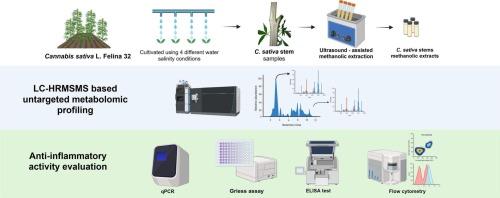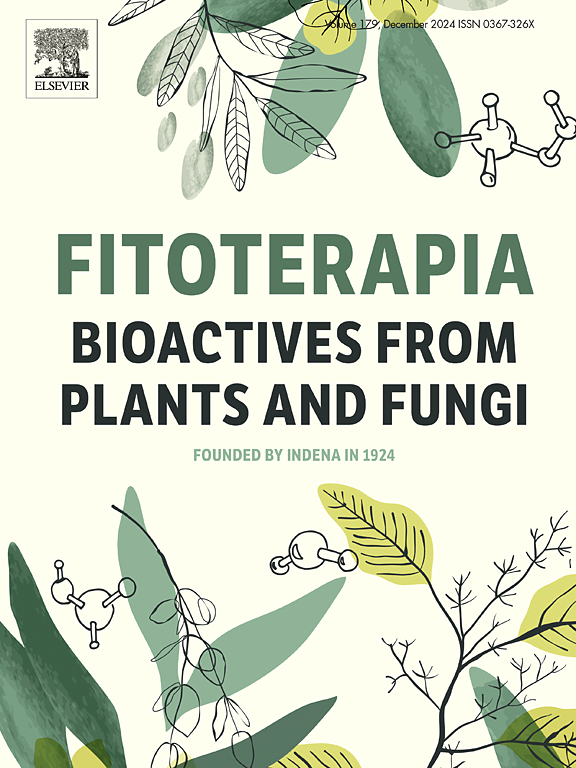From waste to value: evaluation of chemical composition and anti-inflammatory activity of Cannabis sativa stem extracts
IF 2.6
3区 医学
Q3 CHEMISTRY, MEDICINAL
引用次数: 0
Abstract
Cannabis sativa L. is a chemically diverse plant historically valued for its nutritional, textile, and medicinal properties. While the pharmacological relevance of inflorescences and seeds is well-established, the stems are commonly considered waste. In this study, we investigated the chemical composition and anti-inflammatory activity of stem extracts from fiber hemp (C. sativa, Felina 32), cultivated under saline irrigation at different electrical conductivities (0, 2.0, 4.0, and 6.0 dS m−1). LC-HRMS analysis revealed the presence of diverse secondary metabolites, predominantly flavonoid glycosides and alkaloids, with minimal phytocannabinoid content. Extracts exhibited differential metabolomic profiles influenced by salinity, with higher phenolic content under high salinity, suggesting stress-induced biosynthetic responses. Functional assays in J774A.1 macrophages demonstrated that all stem extracts significantly suppressed inflammatory responses, reducing IL-6 expression, calcium flux, iNOS and COX2 expression, and secretion of NO and PGE2. These findings highlight the potential of C. sativa stem by-products as sustainable sources of bioactive compounds with anti-inflammatory properties, promoting their revaluation within circular economy models.

从废物到价值:大麻茎提取物的化学成分和抗炎活性评价
大麻是一种化学成分多样的植物,历史上因其营养、纺织和药用特性而受到重视。虽然花序和种子的药理学相关性是公认的,但茎通常被认为是废物。在这项研究中,我们研究了在不同电导率(0、2.0、4.0和6.0 dS m−1)的盐水灌溉下种植的大麻纤维(C. sativa, Felina 32)茎提取物的化学成分和抗炎活性。LC-HRMS分析显示,其次生代谢产物以黄酮类苷和生物碱为主,大麻素含量极少。受盐度影响,提取物表现出不同的代谢组学特征,在高盐度条件下,酚类物质含量较高,表明胁迫诱导的生物合成反应。J774A.1巨噬细胞的功能检测显示,所有茎提取物均能显著抑制炎症反应,降低IL-6表达、钙通量、iNOS和COX2表达以及NO和PGE2的分泌。这些发现强调了苜蓿茎副产物作为具有抗炎特性的生物活性化合物的可持续来源的潜力,促进了它们在循环经济模型中的重新评估。
本文章由计算机程序翻译,如有差异,请以英文原文为准。
求助全文
约1分钟内获得全文
求助全文
来源期刊

Fitoterapia
医学-药学
CiteScore
5.80
自引率
2.90%
发文量
198
审稿时长
1.5 months
期刊介绍:
Fitoterapia is a Journal dedicated to medicinal plants and to bioactive natural products of plant origin. It publishes original contributions in seven major areas:
1. Characterization of active ingredients of medicinal plants
2. Development of standardization method for bioactive plant extracts and natural products
3. Identification of bioactivity in plant extracts
4. Identification of targets and mechanism of activity of plant extracts
5. Production and genomic characterization of medicinal plants biomass
6. Chemistry and biochemistry of bioactive natural products of plant origin
7. Critical reviews of the historical, clinical and legal status of medicinal plants, and accounts on topical issues.
 求助内容:
求助内容: 应助结果提醒方式:
应助结果提醒方式:


